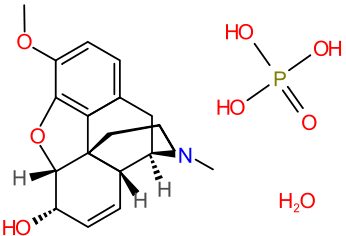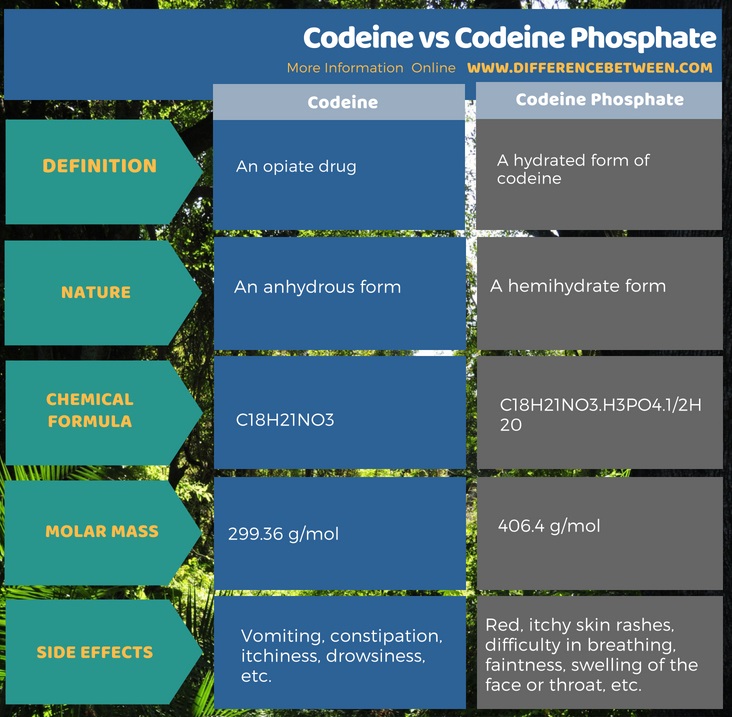Difference Between Codeine and Codeine Phosphate
The key difference between Codeine and Codeine phosphate is that codeine does not contain any phosphorous whereas codeine phosphate contains phosphorous in the form of phosphate.
Codeine is a form of medication that is important to treat pain, especially the pain arising in coughing. In addition, we can use it to treat diarrhoea. Codeine phosphate tablets, on the other hand, are also useful in treating mild to moderate pain. The active agent in this medicine is codeine phosphate hemihydrate.
CONTENTS
1. Overview and Key Difference
2. What is Codeine
3. What is Codeine Phosphate
4. Side by Side Comparison – Codeine vs Codeine Phosphate in Tabular Form
5. Summary
What is Codeine?
Codeine is an opiate. This means it is a drug derived from opium plant. This drug is important to treat pain, to treat cough and diarrhoea. The drug is suitable for mild to moderate pains only. The chemical formula of the drug is C18H21NO3. Therefore its molar mass is 299.36 g/mol. It is an anhydrous drug. This drug is manufactured as a colorless to white crystalline solid powder. And this powder undergoes sublimation at 284°F.
Furthermore, the drug is odourless and has a bitter taste. The melting point of the drug is 157.5 °C while the boiling point is 250 °C. However, when the compound is heated until decomposition, it emits nitrogen oxides. The side effects of this drug include vomiting, constipation, itchiness, drowsiness, etc.
What is Codeine Phosphate?
Codeine phosphate is a hydrated form of codeine. The active agent in this drug is codeine phosphate hemihydrate. This drug belongs to a group of drugs; we call them analgesics. These drugs are useful in blocking pain; mild to moderate pain. Since it is a derivative of codeine, this drug is also an opiate. In addition, we can use this drug to relief from the symptoms of diarrhoea.

Figure 01: The Chemical Structure of Codeine Phosphate
The chemical formula of the active agent of this drug is C18H21NO3.H3PO4.1/2H20. Therefore, the molar mass is 406.4 g/mol. The compound is freely soluble in water. The common side effect of this drug includes red, itchy skin rashes, difficulty in breathing, faintness, swelling of the face or throat, etc.
What is the Difference Between Codeine and Codeine Phosphate?
Codeine is an opiate drug. This means we can obtain it from the opium plant. Codeine phosphate is a derivative of codeine. Hence, it is also an opiate. Both these drugs are analgesics; a class of drugs which we use to relieve pain. Codeine is an anhydrous form while codeine phosphate is a hydrated form. That is because the active compound in codeine phosphate is codeine phosphate hemihydrate. The chemical formula of codeine is C18H21NO3, but the chemical formula of codeine phosphate hemihydrate is C18H21NO3.H3PO4.1/2H20.

Summary – Codeine vs Codeine Phosphate
Codeine and codeine phosphate are two forms of the same drug. We classify these drugs as opiates because these are useful to relieve mild to moderate pain. The difference between Codeine and Codeine phosphate is that codeine does not contain any phosphorous whereas codeine phosphate contains phosphorous in the form of phosphate.
Reference:
1. “Codeine.” Wikipedia, Wikimedia Foundation, 5 June 2018. Available here
2. “Codeine.” National Center for Biotechnology Information. PubChem Compound Database, U.S. National Library of Medicine. Available here
Image Courtesy:
1.’Codeine phosphate’By RicHard-59 – Own work, (CC BY-SA 3.0) via Commons Wikimedia
ncG1vNJzZmivp6x7pbXFn5yrnZ6YsqOx07CcnqZemLyue8OinZ%2Bdopq7pLGMm5ytr5Wau26vzp2coqaVYq6vsIycpp2dmaOybrzHqKqpoJGpsnA%3D